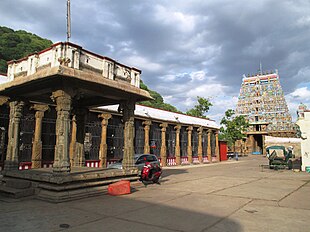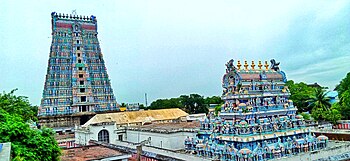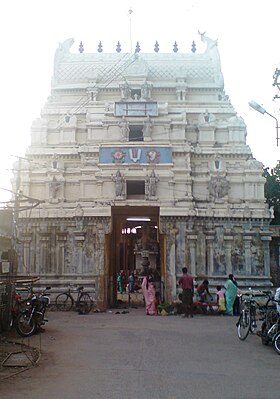5.1 பண்டைத் தமிழ் இலக்கியங்களில் மகாபாரதச் செய்திகள்
பண்டைத் தமிழ் இலக்கியங்களில் மகாபாரதம் பற்றிப் பல செய்திகளும் குறிப்புகளும் இடம் பெற்றுள்ளன. இவை, மகாபாரதம் எந்த அளவுக்குச் செல்வாக்குப் பெற்றிருந்தது என்பதனை எடுத்துரைக்கின்றன.
பாண்டவர்களும் கௌரவர்களும் போரிட்டபோது தமிழ் மன்னன் ஒருவன் இருபடையினருக்கும் பெருஞ்சோறு அளித்ததாகச் சங்க இலக்கியங்கள் கூறியுள்ளன. பெருஞ்சோறு என்பது போர் வீரர்களுக்கு விருந்தாக அளிக்கப் பெறும் உணவு ஆகும். இதனை அளித்ததால் அத்தமிழ் மன்னன் பெருஞ்சோற்று உதியன் சேரலாதன் என்று அழைக்கப்பெற்றான்.
அலங்குஉளைப் புரவி ஐவரொடு சினைஇ
நிலம்தலைக் கொண்ட பொலம்பூந் தும்பை
ஈரைம் பதின்மரும் பொருதுகளத் தொழியப்
பெருஞ்சோற்று மிகுபதம் வரையாது கொடுத்தோய் (புறநானூறு - 2)
(அலங்கு = அசைகின்ற; உளை = பிடரி மயிர்; புரவி = குதிரை; ஐவர் = பாண்டவர் / தருமன், வீமன், அருச்சுனன், நகுலன், சகாதேவன்; பொலம் = பொன்; தும்பை = வலிமை காரணமாகப் போர்புரியும் வீரர்கள் அணியும் பூ / தும்பைப் பூ; ஈரைம்பதின்பர் = நூற்றுவர் / துரியோதனன் முதலிய நூறு சகோதரர்கள்; ஒழிய = சாவ; பதம் = சோறு, உணவு; வரையாது = அளவில்லாது)
பெருஞ்சோற்று உதியன் சேரலாதன் பாரதப் போர் நிகழ்ந்த காலத்தில் பெருஞ்சோறு அளித்த நிகழ்ச்சியை இப்பாடல் விவரிக்கிறது. துரியோதனன் முதலிய கௌரவர் நூற்றுவரும் பாண்டவர் ஐவரோடு பகைத்துப் போரிட்டனர்; போரிட்டு மாண்டனர். அப்போர்க்களத்தில் சேரலாதன் போர் வீரர்களுக்குப் பெருஞ்சோறு அளித்துச் சிறப்புச் செய்துள்ளான் என்பது இப்பாடலின் பொருள்.
காவெரி ஊட்டிய கவர்கணைத் தூணிப்
பூவிரி கச்சைப் புகழோன் தம்முன் (சிறுபாணாற்றுப்படை அடிகள், 238-239)
(கா = காடு, வனம், காண்டவ வனம்; எரி = தீ; காவெரி ஊட்டல் = காண்டவ வனம் எரியூட்டப் பெறுதல்; கவர் = பல; கணை = அம்பு; தூணி = அம்பு வைக்கும் கூடு; கச்சை = ஆடை வகை)
என்ற பாடல் பாண்டவருள் அருச்சுனனையும் வீமனையும் குறிப்பிடுகிறது.
காட்டிற்கு எரி ஊட்டியவனும், அம்புகள் நிரம்பிய அம்புக் கூட்டை உடையவனும், கச்சையை அணிந்தவனும் ஆகிய புகழை உடையவன் அருச்சுனன். அவனுடைய தம் முன் (மூத்தவன்) வீமன் ஆவான் என்பது இப்பாடல் வரிகளின் பொருள். மேலும் வீமனின் சமையல் சிறப்பும் சிறுபாணாற்றுப்படையில் குறிப்பிடப்பட்டுள்ளது.
பதிற்றுப் பத்தின் பாடல் (14) ஒன்று, கௌரவர் நண்பனாகிய கர்ணனை அக்குரன் என்று கூறியுள்ளது. கர்ணன் ஞாயிற்றின் மகனாகக் கலித்தொகைப் பாடல் ஒன்றில் குறிக்கப்பெற்றுள்ளான் (முல்லைக் கலி, 28). துரியோதனன் முதலியோர் சூழ்ச்சியால் பாண்டவர் தங்கி இருந்த அரக்கு மாளிகை தீ வைக்கப்படுகிறது. அத்தீயிலிருந்து வீமன் தன் சகோதரர்களைக் காப்பாற்றிய நிகழ்ச்சியை மற்றொரு கலித்தொகைப் பாடல் (பாலைக்கலி, 25) விவரித்துள்ளது.
பெரும்பாணாற்றுப்படையில், பாண்டவர் ஐவரும் கௌரவர் நூற்றுவரைப் போர்க்களத்தே வென்ற செய்தி கூறப்பட்டுள்ளது.
ஈரைம் பதின்மரும் பொருதுகளத்து அவியப்
பேரமர்க் கடந்த கொடிஞ்சி நெடுந்தேர்
ஆராச் செருவின் ஐவர் போல
(பெரும்பாணாற்றுப்படை அடிகள், 415-417)
(ஈரைம் பதின்மர் = கௌரவர் நூற்றுவர்; பொருது = சண்டை இட்டு; களத்து = போர்க் களத்து; அவிய = இறக்க; பேர் = பெரிய; அமர்க் கடந்த = வெற்றி பெற்ற; கொடிஞ்சி = தேரின் ஒரு பகுதி; ஆரா = தணியாத; செரு = போர்; ஐவர் = பாண்டவர்)
பெரிய வெற்றியைப் பெற்றவர் பாண்டவர்; இவர்கள் நெடிய தேரினையும் தீராத போர் வேட்கையையும் உடையவர்கள்; கௌரவர்கள் நூறு பேரும் போர்க்களத்தில் இறக்குமாறு இவர்கள் பெரிய வெற்றியைப் பெற்றார்கள் என்பது இவ்வரிகளின் பொருள்.
இவ்வாறான பலவேறு குறிப்புகள், சங்க காலத்திலேயே தமிழகத்தில் மகாபாரதம் நிலவி இருந்ததைத் தெரியப்படுத்துகின்றன.















